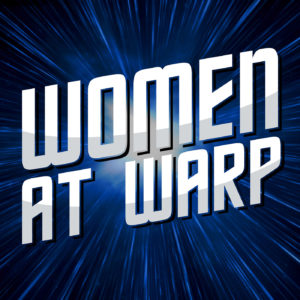The Star Trek Universe: Franchising the Final Frontier, Douglas and Shea T. Brode’s new collection of essays, is a sampling of academic insights into various aspects of the Star Trek fandom, including examinations of gender, race, sexual orientation throughout the franchise.
The Brodes’ introduction – which could almost stand on its own as an essay exploring the concept of authorship and the influence of Gene Roddenberry on the franchise – states the goal of the book is “to present Trek without tears through chapters that remain respectful though never naively worshipful, admiring if not uncritically so, appreciative yet devoid of naivete.”
The tone the Brodes describe may be the only thing that unites the essays other than relating to Star Trekin some way, shape or form. The collection feels like a multi-course meal made up entirely of appetizers, with each one giving you only a taste of how rich its topic could be.
That’s not to say the book isn’t enjoyable or valuable – it is both. It’s also one of the more accessible academic explorations of Star Trek that I’ve read, meaning that Trek fans don’t need to have an academic background to appreciate the ideas raised.
For example, I really enjoyed the fun and thought-provoking essay on Trek action figures by Jonathan Alexandratos (disclosure: friend and past contributor to my other blog, Gender Focus). Alexandratos looks at the Galoob and Playmates TNG action figures, studying the accessories, production numbers, and variants to reveal how the toy manufacturing reinforced gender inequality and stereotyping. Alexandratos writes:
“Unfortunately, these commanding female characters as represented in plastic reveal women stripped of their might. Phasers are replaced by shoulder bags. Action features are toned down. Some key characters are not presented at all, seemingly in favour of another variant of another male figure. This does a disservice to Trek’s women, who, on multiple occasions, display strength, bravery, and overall ability on par with their male counterparts.”
One of the things that makes Alexandratos’ essay a success is that its scope is limited enough to do the topic justice in the space provided. Similarly, Denise Alessandria Hurd’s essay “Forward to the Past” is a thoughtful exploration of miscegenation fears and how they manifest in depictions of hybrid Trek characters (Spock, Troi, K’Ehleyr, B’Elanna etc.).
I had always assumed these depictions were mainly positive, by bringing the alien a bit closer to the human in order to help the audience see that inner similarities are more important the outward differences. But Hurd complicates this idea, pointing out that many of these characters’ hybridity becomes what defines them, at times even implying innate racial traits, such as when B’Elanna is split into two beings, one fully Klingon and the other fully human.
“Like Troi before her, B’Elanna is established as a hybrid merely to give the audience insight into her…B’Elanna physically lashes out at people; her only explanation, accepted as reasonable, is that sometimes her blood becomes difficult to control. This statement is contradictory to scientific facts established in the Trek universe: the DNA of all humanoid species in the galaxy derives from a single race.”
Unfortunately, Hurd’s analysis was written before Enterprise aired and does not appear to account for later seasons of Voyager.
Two more essays that were highlights for me were related to the Borg. In Tama Leaver’s exploration of gender identity and the Borg, she looks at the Borg Queen and Seven of Nine and how they destabilize conventional notions of gender, at least until Seven’s radical performativity is “closed off” by the “normalizing heterosexual male lover interest” – Chakotay.
In “Star Trek and the Information Age,” Anthony Rotolo uses the Borg as a way to explore how our modern society is mediated by changing technology. Rotolo writes:
“The Borg exists as the ultimate social network: a race of technologically-enhanced beings created through the assimilation of once-independent individuals and countless alien technologies. In the Borg, we find a dangerous enemy crafted not from the fear of being replaced by technology, but rather an all-too-familiar twenty-first-century nightmare of actually becoming technology ourselves.”
Unfortunately, a few of of the essays falter when it comes to intersectional analysis. For example, in “Holodeck History: Past, Present, and Future on the Final Frontier,” Cynthia J. Miller and A. Bowdoin Van Riper look at how the characters participation in historical narratives on the holodeck offers the opportunity to challenge the idea of “authentic” history dictated by an authoritative voice. However, Miller and Van Riper never acknowledge that the holodeck histories we see on Trek are, almost without exception, European or American history, often with white men as the key players.
We’ve got the Alamo, the Battle of Britain, Leonardo da Vinci’s workshop, King Arthur’s court, Vic Fontaine’s 1960s Vegas lounge, occupied France in WWII, Captain Proton, Fair Haven, Data’s poker game with three white guys (Hawking, Einstein and Newton), Charnock’s Comedy Cabaret…and the list goes on. The holodeck might have provided the potential to challenge dominant historical narratives, but I’d argue the show rarely delivered on the potential.
A couple of other essays, like Brian L. Ott and Eric Aoki’s “Science Fiction as Social Consciousness: Race, Gender and Sexuality in Star Trek: The Next Generation” bite off more than they can chew in the span of one chapter and so are unable to really do justice to their subject. For example, their exploration of race is limited to discussing the Klingons and how they can be seen to reproduce negative stereotypes of black masculinity. While this is important to discuss, Trek fans will know the Klingons also draw aspects of their culture from Asian stereotypes. In addition, they just didn’t have space to get into other Trek alien races or depiction of visible minorities in the main TNG crew.
You should still boldly go and seek out this book. Reading something that leaves you hungry for more can be a very good thing. Sample the ideas on offer in The Star Trek Universe: Franchising the Final Frontier, let them spark conversations and inspire you to dig deeper on the topics that most interest you.










